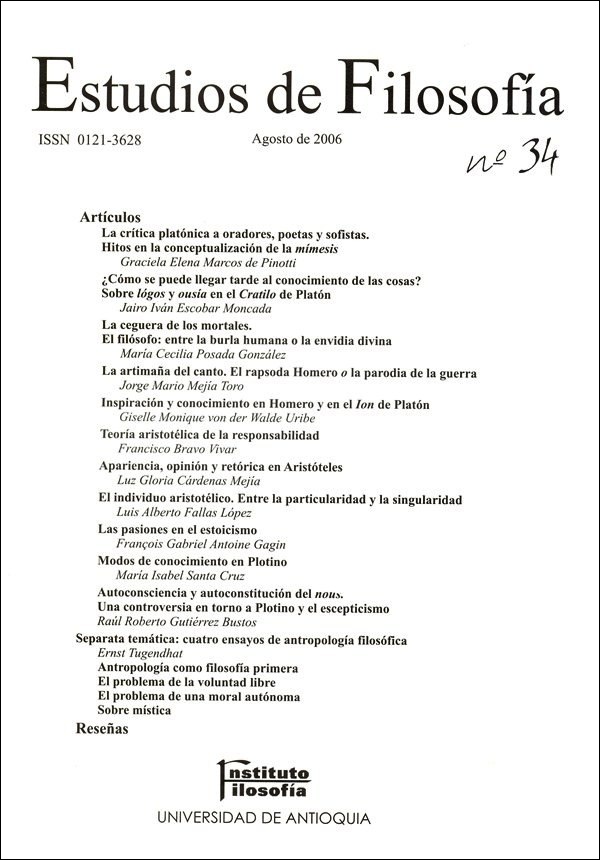Plato's Criticism of Orator, Poets and Sophists. Milestones in the Conceptualization of Mimesis
DOI:
https://doi.org/10.17533/udea.ef.12773Keywords:
Plato, mimesis, Gorgias, Republic, SophistAbstract
This piece focuses on Plato's criticism of orators, poets and sophists. Its purpose is to show that independently of the characteristics that singulartze a battle of a great impact, fought by the Philosopher in three different fronts, the notion of imitation (mimesis) provides a guiding thread that enables bringing together these three fights and throwing light on Plato's reaction to those whom he considers, despisingly, as imitators. The adulatory practice of the orator in Gorgias, no less than the work of the poet that is deeply questioned in the Republic and that of the sophist in the homonymous dialogue would have, in effect, a mimetical nature. This is not an impediment to recognize, besides the continuity aspects, significant differences in the treatments of mimesi that the three dialogues here considered offer.
Downloads
References
Belfiore, E.(1983)."Plato's gratest accusation against poetry", Canadian Journal of Philosophy. Supplementary Volumen. IX, 39-62. DOI: https://doi.org/10.1080/00455091.1983.10715862
Bondeson, W. (1972) . "Plato's Sophist: ralsehoods and images", Apeiron VI, 2, 1-6. DOI: https://doi.org/10.1515/APEIRON.1972.6.2.1
Demand, N. (1975). "Plato and the painters", Phoenix XXIX, 1, 1- 20. DOI: https://doi.org/10.2307/1087580
Dodds, E. (1958). Plato. Gorgias. Oxford, Oxford University Press.
Fine, G. (1993).On ideas. Aristotle’s criticism of Plato’s theory of forms. Oxford, Clarendon, Chapo 6, 81-88.
Gulley, N. (1954). "Plato's theory of recollection", Classical Quarterly IV, 194- 213. DOI: https://doi.org/10.1017/S0009838800008120
Halliwell, S. (2002). The aesthetics of mimesis. Ancient texts and modern problems, Princeton U. P, Part I. DOI: https://doi.org/10.1515/9781400825301
Havelock, Erie A. (1963). Preface to Plato. Harvard U. P. Citado aquí en trad. española: Prefacio a Platón, Madrid, Visor, 1994. DOI: https://doi.org/10.4159/9780674038431
Keuls, E. C. (1978). Plato to greek painting. Leiden, Brill. DOI: https://doi.org/10.1163/9789004450776
Hwang, P.(1981). "Poetry in Plato's Republic", Apeiron XV, 1, 29-37. DOI: https://doi.org/10.1515/APEIRON.1981.15.1.29
Murray, J. S. (1988). "Plato on knowledge, persuasion and the art of rhetoric: Gorgias 4520-455a", Ancient Philosophy 8, 1- 10. DOI: https://doi.org/10.5840/ancientphil19888116
Nehamas, A. (1982). "Plato on imitation and poetry in Republica X", en : J. Moravcsikand P. Temko (eds.), Plato on beauty, wisdom and the ars, Totowa, N. J. Citado aquí en trad. española: "Sobre la imitación y la poesía en República X, trad. E. Ludueña, en AAVV, Lecturas sobre Plolón y Aristóteles VI, Buenos Aires, OPFyL, 2003, pp. 5- 33.
Rodrigo, Pierre. (2001). "Platon et l'art austère de la distanciation", en: Fanal, M. (ed). La philosophie de Platon, tome 1, París, L'Harmanan, pp. 139- 165.
Rossi, G (2003). "¿Retórica o verdad? La 'tercera vía' de Platón", Revista Latinoamericano de Filosofía XXIX, 2, 285- 316.
Taylor, A. E. (1956). Plato: the Man and his Work, N. York, Dover Publications.
Villela-Petit, M.(1991). "La question de I'image artistique dans le Sophiste", en: P. Aubenque et M. Narcy (eds.), Études sur le sophisle de Platon, Biblíopolis, 53-90.
Wieland, W. (1991). "La crítica de Platón a la escritura y los límites de la comunicabilidad", Methexis IV, 19-37 DOI: https://doi.org/10.1163/24680974-90000082
Downloads
Published
How to Cite
Issue
Section
Categories
License
Copyright (c) 2006 Graciela Elena Marcos de Pinotti

This work is licensed under a Creative Commons Attribution-NonCommercial-ShareAlike 4.0 International License.
Authors who publish with this journal agree to the following terms:
1. The Author retains copyright in the Work, where the term "Work" shall include all digital objects that may result in subsequent electronic publication or distribution.
2. Upon acceptance of the Work, the author shall grant to the Publisher the right of first publication of the Work.
3. The Author shall grant to the Publisher a nonexclusive perpetual right and license to publish, archive, and make accessible the Work in whole or in part in all forms of media now or hereafter known under a Creative Commons Attribution-NoCommercia-ShareAlike (CC BY-NC-SA 4.0), or its equivalent, which, for the avoidance of doubt, allows others to copy, distribute, and transmit the Work under the following conditions: (a) Attribution: Other users must attribute the Work in the manner specified by the author as indicated on the journal Web site;(b) Noncommercial: Other users (including Publisher) may not use this Work for commercial purposes;
4. The Author is able to enter into separate, additional contractual arrangements for the nonexclusive distribution of the journal's published version of the Work (e.g., post it to an institutional repository or publish it in a book), as long as there is provided in the document an acknowledgement of its initial publication in this journal;
5. Authors are permitted, and Estudios de Filosofía promotes, to post online the preprint manuscript of the Work in institutional repositories or on their Websites prior to and during the submission process, as it can lead to productive exchanges, as well as earlier and greater citation of published work (see The Effect of Open Access). Any such posting made before acceptance and publication of the Work is expected be updated upon publication to include a reference to the Estudios de Filosofía's assigned URL to the Article and its final published version in Estudios de Filosofía.















